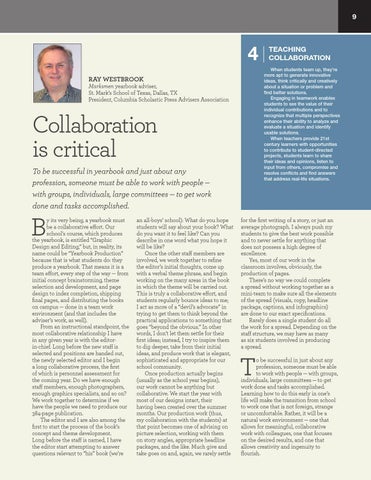9
4
When students team up, they’re more apt to generate innovative ideas, think critically and creatively about a situation or problem and find better solutions. Engaging in teamwork enables students to see the value of their individual contributions and to recognize that multiple perspectives enhance their ability to analyze and evaluate a situation and identify usable solutions. When teachers provide 21st century learners with opportunities to contribute to student-directed projects, students learn to share their ideas and opinions, listen to input from others, compromise and resolve conflicts and find answers that address real-life situations.
Ray Westbrook
Marksmen yearbook adviser, St. Mark’s School of Texas, Dallas, TX President, Columbia Scholastic Press Advisers Association
Collaboration is critical To be successful in yearbook and just about any profession, someone must be able to work with people — with groups, individuals, large committees — to get work done and tasks accomplished.
B
y its very being, a yearbook must be a collaborative effort. Our school’s course, which produces the yearbook, is entitled “Graphic Design and Editing,” but, in reality, its name could be “Yearbook Production” because that is what students do: they produce a yearbook. That means it is a team effort, every step of the way — from initial concept brainstorming, theme selection and development, and page design to index completion, shipping final pages, and distributing the books on campus — done in a team work environment (and that includes the adviser’s work, as well). From an instructional standpoint, the most collaborative relationship I have in any given year is with the editorin-chief. Long before the new staff is selected and positions are handed out, the newly selected editor and I begin a long collaborative process, the first of which is personnel assessment for the coming year. Do we have enough staff members, enough photographers, enough graphics specialists, and so on? We work together to determine if we have the people we need to produce our 384-page publication. The editor and I are also among the first to start the process of the book’s concept and theme development. Long before the staff is named, I have the editor start attempting to answer questions relevant to “his” book (we’re
an all-boys’ school): What do you hope students will say about your book? What do you want it to feel like? Can you describe in one word what you hope it will be like? Once the other staff members are involved, we work together to refine the editor’s initial thoughts, come up with a verbal theme phrase, and begin working on the many areas in the book in which the theme will be carried out. This is truly a collaborative effort, and students regularly bounce ideas to me; I act as more of a “devil’s advocate” in trying to get them to think beyond the practical applications to something that goes “beyond the obvious.” In other words, I don’t let them settle for their first ideas; instead, I try to inspire them to dig deeper, take from their initial ideas, and produce work that is elegant, sophisticated and appropriate for our school community. Once production actually begins (usually as the school year begins), our work cannot be anything but collaborative. We start the year with most of our designs intact, their having been created over the summer months. Our production work (thus, my collaboration with the students) at that point becomes one of advising on picture selection, working with them on story angles, appropriate headline packages, and the like. Much give and take goes on and, again, we rarely settle
Teaching collaboration
for the first writing of a story, or just an average photograph. I always push my students to give the best work possible and to never settle for anything that does not possess a high degree of excellence. Yes, most of our work in the classroom involves, obviously, the production of pages. There’s no way we could complete a spread without working together as a mini-team to make sure all the elements of the spread (visuals, copy, headline package, captions, and infographics) are done to our exact specifications. Rarely does a single student do all the work for a spread. Depending on the staff structure, we may have as many as six students involved in producing a spread.
T
o be successful in just about any profession, someone must be able to work with people — with groups, individuals, large committees — to get work done and tasks accomplished. Learning how to do this early in one’s life will make the transition from school to work one that is not foreign, strange or uncomfortable. Rather, it will be a natural work environment — one that allows for meaningful, collaborative work with colleagues, one that focuses on the desired results, and one that allows creativity and ingenuity to flourish.
